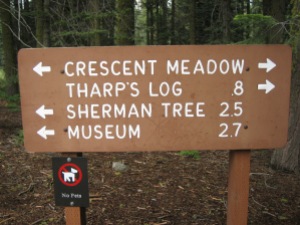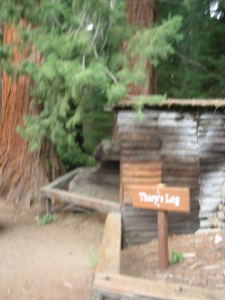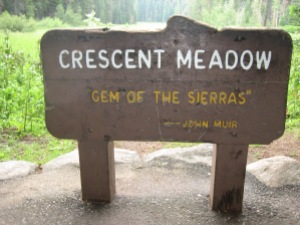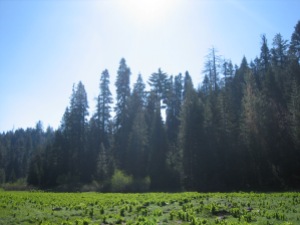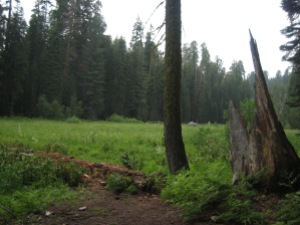 It wasn’t even winter yet, when I visited Calaveras Big Trees State Park. It was only December 1, but already ice and snow covered the ground.
It wasn’t even winter yet, when I visited Calaveras Big Trees State Park. It was only December 1, but already ice and snow covered the ground.
I hadn’t considered how a 1,500 feet increase in elevation can make a big difference in temperature and weather, so I was a bit surprised to see ice and snow on the side of the road as the van climbed above the 4,ooo feet mark. This is going to be fun, I thought.
Luckily, I was properly dressed with hiking boots, jeans, a warm sweater over a long sleeve t-shirt, and my jorongo over it all. Thankfully, I remembered to grab some gloves before I left the van.
The Calaveras Big Trees State Park is proud of their trees. It costs $10 per vehicle for admission, unless you’re arriving in a bus. Buses carrying up to 24 passengers have to pay $50 for admission. It costs $100 to bring in a bus carrying more than 24 passengers. You can bet I’m going to inform people of these prices next summer when they complain about paying $5 to park where I work.
I started my State Park adventure in the visitors center. The very friendly man who took my $10 at the entrance  told me that’s where I could pick up a guide for the North Grove trail. The man didn’t tell me they want 50 cents for the guide. I hadn’t put any money in my pockets because I hadn’t planned to buy any souvenirs, and I didn’t think the trees were going to panhandle me. When I told the women in the gift shop area of the visitors center that I hadn’t brought any money in with me, she told me to pick up a guide from the metal box at the start of the trail.
told me that’s where I could pick up a guide for the North Grove trail. The man didn’t tell me they want 50 cents for the guide. I hadn’t put any money in my pockets because I hadn’t planned to buy any souvenirs, and I didn’t think the trees were going to panhandle me. When I told the women in the gift shop area of the visitors center that I hadn’t brought any money in with me, she told me to pick up a guide from the metal box at the start of the trail.
I took the guide that looked as if it had already been borrowed and returned. Upon seeing the guide, I understood why the park wants to collect some money for it. The guide is a booklet (not one page folded in three parts, which is what I think of as a trail guide due to what I’ve given out where I work), five letter size pages folded in half. The guide includes a lot of information.
Before I took the guide and started my icy hike, I walked through the gift shop to the exhibit area of the visitor center. In the middle of the room was a display of taxidermied animals. I didn’t stop to examine them, as I don’t particularly like seeing animals killed so humans can look at them. I did look at the exhibits on the walls, which started with information about the native people who lived in the area before the miners and pioneers showed up. There was also information about the “discovery” of the trees in the park by white folks and the subsequent destruction of some of the largest ones.
One of the trees destroyed was called the Discovery Tree. According to the guidebook,
[i]n 1853…[this tree] was stripped of its bark and felled by ambitious speculators. Since no saw was large enough, the tree was felled with…long-handled pump augers and wedges…It took five men 22 days to drill all the holes, but the perfectly symmetrical tree did not fall for several days.
The stump was planed smooth to serve as a dance floor, and a two-lane bowling alley and bar were built on the fallen trunk.
John Muir…was so angered by these events that he wrote: The vandals then danced upon the stump!
The North Grove trail took me to the remains of the Discovery Tree. It is enormous! It’s difficult to understand from photographs how huge this

This photo shows the fallen trunk of the Discovery Tree, upon which a bar and bowling alley were built.
tree is. I climbed carefully up the icy steps and stood on the stump of the Discovery Tree. I felt very sad when thinking about this tree being killed by people who wanted to make money exhibiting its parts. The trail guide says the tree was only 1.244 years old when it was cut. Since some giant sequoias live to be over 3,000 years old, the Discovery Tree may have had many more years of life ahead of it, had it not been destroyed in its prime.
Another tree in the park destroyed by humans was the Mother of the Forest. The trail guide says,
In 1854 the “Mother of the Forest…” was stripped of its bark. Promoters schemed to ship the bark strips back east for reassembly at exhibitions…A crew of men worked at the tree’s systematic destruction for ninety days…It was through the Mother of the Forest’s great sacrifice that a heightened awareness about the need to protect these trees was born.
At the back of the exhibit area in the visitors center is a theater running a couple of documentary films on a loop. The films give a history of the park, including how the destruction of the Discovery Tree and the Mother of the Forest led to people working to protect the trees, including the creation of Calaveras State Park.
After my time in the visitors center, I started out on my walk through the trees. I found the trail was covered in ice and snow: no clearing the trail or shoveling snow here! The trail was only visible because the snow had been packed down where people had walked. The packed snow in the middle of the trail had turned to ice and was very slippery. I wished I had remembered to carry my walking stick with me. To avoid the worst of the icy slippiness, I mostly walked on the edge of the trail, where the snow was still crunchy and my boots could gain some traction. Unfortunately, walking through the snow meant repetitively sinking up to my ankles.
Still, I was glad I was there. I didn’t feel uncomfortably cold, and I enjoyed the  extra quiet the blanket of snow brought to the forest. When the sun broke through the clouds and trees and hit the ice and the whole world shimmered, well, those moments were glorious.
extra quiet the blanket of snow brought to the forest. When the sun broke through the clouds and trees and hit the ice and the whole world shimmered, well, those moments were glorious.
The North Grove of Calaveras Big Trees State Park is the sixth grove of giant sequoias I’ve visited. I think my trek through the ice and snow to look at new giant sequoias makes it official: I’m a fanatic!

This photo shows me walking through a gap cut in a tree called Hercules. The trail guide says Hercules “was one of the largest in the grove. It was blown down during a violent windstorm in December 1861.”


